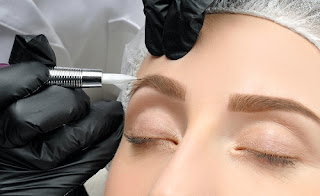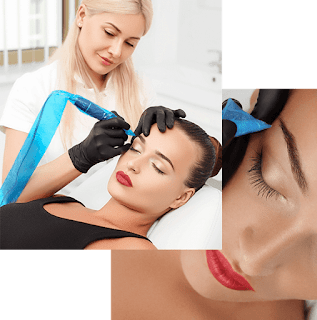Step-By-Step Guide On How To Become A Microblading Artist
So, you want to become a microblading artist. The only question now is: how? In this article, we provide a step-by-step guide on how to become a microblading artist—and the best one at that.
There’s a number of benefits to becoming a microblading artist. Microblading is a great way not just to earn money, but also to express your creativity and meet new people. We artists can even take it one step further and help save the environment just by switching to organic microblading ink pigments.
Not to mention that makeup, both permanent and temporary, has always been a way for women to feel beautiful about themselves. As microblading artists, we help them do just that.
Ready to take the first step? Here’s how.
How to become a microblading artist
Becoming a microblading artist is nowhere near complicated. In fact, you only really need to follow three steps:
What microblading is
The word microblading refers to the technique used by artists to color in the eyebrows, lips, scalp, and more.
Technically speaking, microblading is a form of tattooing. Artists use a pointed device to inject ink into a client’s skin. It’s called “microblading” because artists use microblades, creating tiny, often hair-like strokes to create a natural-looking effect.
You can microblade several areas of the body, including the brows, lips, lash line, scalp, and areolas.
Who can become a microblading artist
Anyone can become a microblading artist. Most microblading training programs welcome beginners. Of course, there are also classes specifically for intermediate and advanced students.
There really are no special requirements needed to become a microblading artist. You just need to enroll in a training class, as well as have the determination, drive, and dedication to perform well.
Why become a microblading artist
Microblading artists have it good, compared to the rest of the beauty industry. We get paid better, and there are fewer of us (which sometimes means more clients than we know what to do with!).
The reason microblading isn’t as widespread a career is that it needs a certain level of investment. Training classes aren’t exactly as cheap as a Big Mac. Plus, if you want to fly solo and freelance, then you’ll need to own all the tools and equipment you need to perform a job. (Of course, you can always work for a microblading salon that already has the tools you need.)
All that said, microblading is a rewarding career. You get to work for inspiring clients and with other hardworking artists. And, like we said, we get paid pretty well.
Where to get microblading training
There are tons of microblading classes near me available. When choosing a school, always screen for:
When to get certified
Certification is crucial in your career. It lets your clients know that the state itself trusts your services. You can get certified as soon as you finish training. Requirements depend on the state.
There’s a number of benefits to becoming a microblading artist. Microblading is a great way not just to earn money, but also to express your creativity and meet new people. We artists can even take it one step further and help save the environment just by switching to organic microblading ink pigments.
Not to mention that makeup, both permanent and temporary, has always been a way for women to feel beautiful about themselves. As microblading artists, we help them do just that.
Ready to take the first step? Here’s how.
How to become a microblading artist
Becoming a microblading artist is nowhere near complicated. In fact, you only really need to follow three steps:
- get trained
- get certified
- find clients
What microblading is
The word microblading refers to the technique used by artists to color in the eyebrows, lips, scalp, and more.
Technically speaking, microblading is a form of tattooing. Artists use a pointed device to inject ink into a client’s skin. It’s called “microblading” because artists use microblades, creating tiny, often hair-like strokes to create a natural-looking effect.
You can microblade several areas of the body, including the brows, lips, lash line, scalp, and areolas.
Who can become a microblading artist
Anyone can become a microblading artist. Most microblading training programs welcome beginners. Of course, there are also classes specifically for intermediate and advanced students.
There really are no special requirements needed to become a microblading artist. You just need to enroll in a training class, as well as have the determination, drive, and dedication to perform well.
Why become a microblading artist
Microblading artists have it good, compared to the rest of the beauty industry. We get paid better, and there are fewer of us (which sometimes means more clients than we know what to do with!).
The reason microblading isn’t as widespread a career is that it needs a certain level of investment. Training classes aren’t exactly as cheap as a Big Mac. Plus, if you want to fly solo and freelance, then you’ll need to own all the tools and equipment you need to perform a job. (Of course, you can always work for a microblading salon that already has the tools you need.)
All that said, microblading is a rewarding career. You get to work for inspiring clients and with other hardworking artists. And, like we said, we get paid pretty well.
Where to get microblading training
There are tons of microblading classes near me available. When choosing a school, always screen for:
- Expertise. Find a school whose teachers are certified experts in the industry. If you get a chance to learn from industry pioneers and who have worked on many different microblading jobs, then grab that chance.
- Distance. Enrolling in a training school far from your home will make coming to class difficult. The best schools don’t offer more than a month’s worth of training. If you’ve found a school you really want, you can always get temporary board and lodging.
- Curriculum. Microblading training schools should have a published curriculum on their websites. This way, students know what they’re signing up for.
- Hands-on learning. Don’t settle for a “training school” that doesn’t actually do any training. Find an academy that will show you how to perform the procedure on realistic dummies and on real clients.
- Support. What kind of support does your school have to offer? Some schools offer free lodging. Others encourage you to contact instructors via phone or email for any questions. Find a school that makes you feel motivated and encouraged.
- Career opportunities. Once you’ve completed your training, how can your school help you with your career? Do they give you the option of working with them? Do they have contacts in the beauty industry? An established training school will be able to help you land a great first job after your education.
When to get certified
Certification is crucial in your career. It lets your clients know that the state itself trusts your services. You can get certified as soon as you finish training. Requirements depend on the state.



Comments
Post a Comment